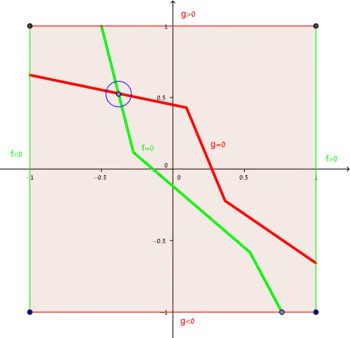In mathematics, the Poincaré–Miranda theorem is a generalization of intermediate value theorem, from a single function in a single dimension, to n functions in n dimensions. It says as follows:
- Consider continuous, real-valued functions of variables, . Assume that for each variable , the function is nonpositive when and nonnegative when . Then there is a point in the -dimensional cube in which all functions are simultaneously equal to .
The theorem is named after Henri Poincaré - who conjectured it in 1883 - and Carlo Miranda - who in 1940 showed that it is equivalent to the Brouwer fixed-point theorem.[1][2]: 545 [3] It is sometimes called the Miranda theorem or the Bolzano-Poincare-Miranda theorem.[4]
Intuitive description

The picture on the right shows an illustration of the Poincaré–Miranda theorem for n = 2 functions. Consider a couple of functions (f,g) whose domain of definition is [-1,1]2 (i.e., the unit square). The function f is negative on the left boundary and positive on the right boundary (green sides of the square), while the function g is negative on the lower boundary and positive on the upper boundary (red sides of the square). When we go from left to right along any path, we must go through a point in which f is 0. Therefore, there must be a "wall" separating the left from the right, along which f is 0 (green curve inside the square). Similarly, there must be a "wall" separating the top from the bottom, along which g is 0 (red curve inside the square). These walls must intersect in a point in which both functions are 0 (blue point inside the square).
Generalizations
The simplest generalization, as a matter of fact a corollary, of this theorem is the following one. For every variable xi, let ai be any value in the range [supxi = 0 fi, infxi = 1 fi]. Then there is a point in the unit cube in which for all i:
- .
This statement can be reduced to the original one by a simple translation of axes,
where
- xi are the coordinates in the domain of the function
- yi are the coordinates in the codomain of the function.
By using topological degree theory it is possible to prove yet another generalization.[5] Poincare-Miranda was also generalized to infinite-dimensional spaces.[6]
References
- ↑ Miranda, Carlo (1940), "Un'osservazione su un teorema di Brouwer", Bollettino dell'Unione Matematica Italiana, Serie 2 (in Italian), 3: 5–7, JFM 66.0217.01, MR 0004775, Zbl 0024.02203
- ↑ Kulpa, Wladyslaw (June 1997), "The Poincare-Miranda Theorem", The American Mathematical Monthly, 104 (6): 545–550, doi:10.2307/2975081, JSTOR 2975081, MR 1453657, Zbl 0891.47040
- ↑ Dugundji, James; Granas, Andrzej (2003), Fixed Point Theory, Springer Monographs in Mathematics, New York: Springer-Verlag, pp. xv+690, ISBN 0-387-00173-5, MR 1987179, Zbl 1025.47002
- ↑ Vrahatis, Michael N. (2016-04-01). "Generalization of the Bolzano theorem for simplices". Topology and its Applications. 202: 40–46. doi:10.1016/j.topol.2015.12.066. ISSN 0166-8641.
- ↑ Vrahatis, Michael N. (1989). "A short proof and a generalization of Miranda's existence theorem". Proceedings of the American Mathematical Society. 107 (3): 701–703. doi:10.1090/S0002-9939-1989-0993760-8. ISSN 0002-9939.
- ↑ Schäfer, Uwe (2007-12-05). "A Fixed Point Theorem Based on Miranda". Fixed Point Theory and Applications. 2007 (1): 078706. doi:10.1155/2007/78706. ISSN 1687-1812.
Further reading
- Ahlbach, Connor Thomas (2013). "A Discrete Approach to the Poincare–Miranda Theorem (HMC Senior Theses)". Retrieved 18 May 2015.
- Alefeld, Götz; Frommer, Andreas; Heindl, Gerhard; Mayer, Jan (2004). "On the existence theorems of Kantorovich, Miranda and Borsuk". ETNA. Electronic Transactions on Numerical Analysis [electronic only]. 18: 102–111.